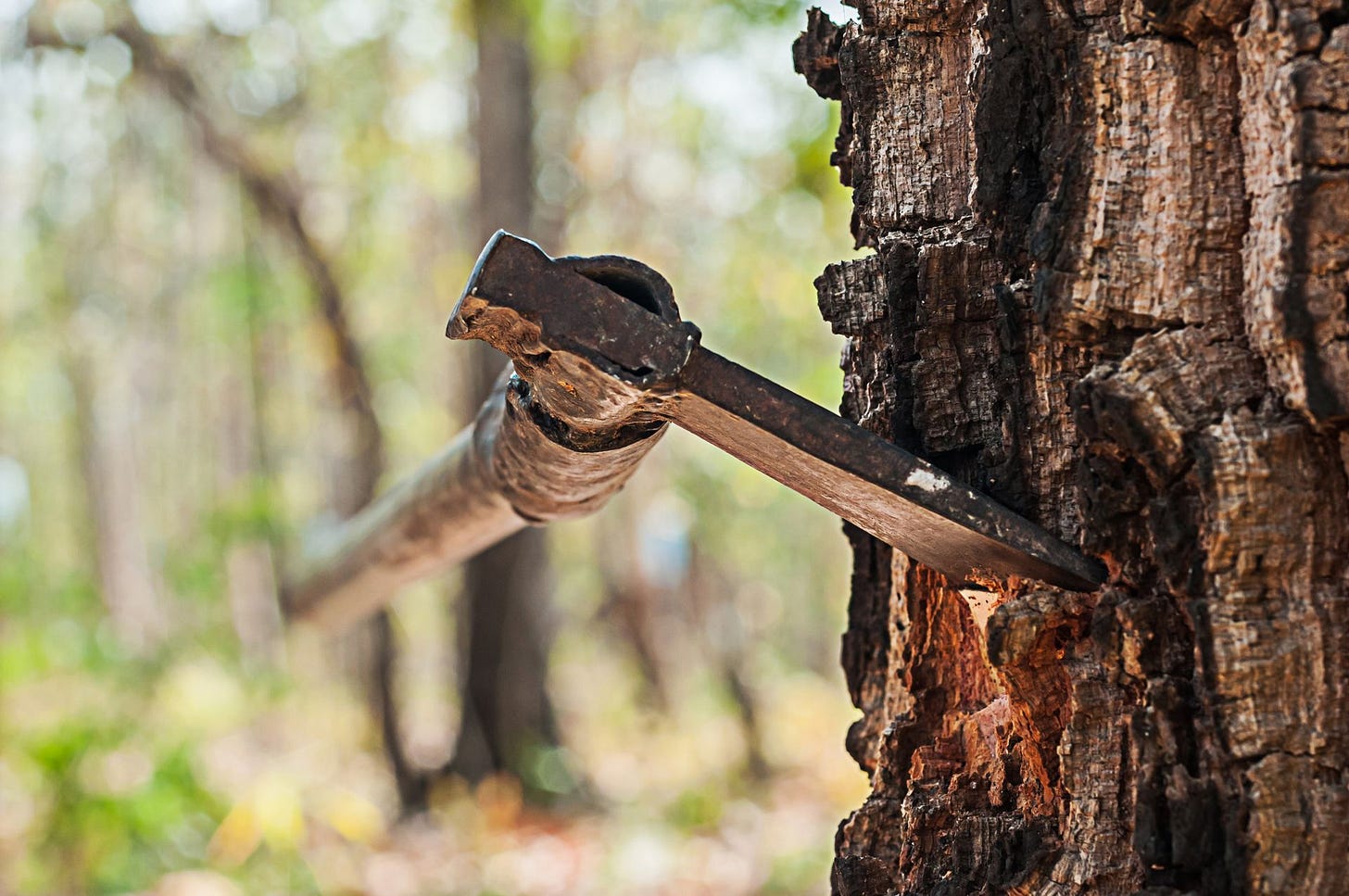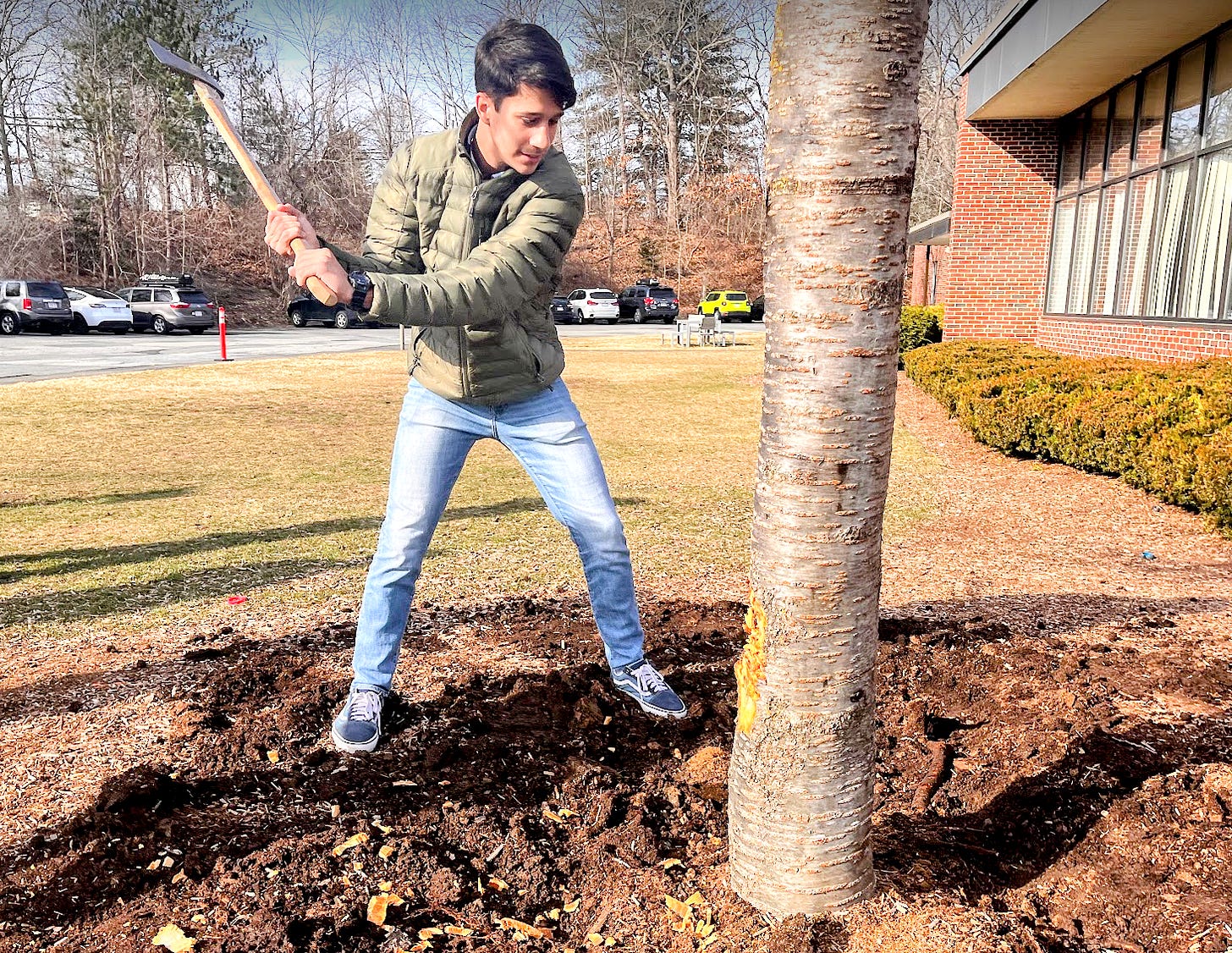
Me: “Those cherries out front have been dead for a year. We should take them down.”
Administration: “How much would that cost?”
Me: “Around $1,200 for the removal, and $250 for new trees.”
Administration: “We could afford that…if all we had to pay was the $250 for the new trees.”
Me: “I have a crazy idea.”
Administration: “We’re listening.”
Over the last few months, I have talked a lot about why schools should provide hands-on, communal experiences for students, preferably outdoors. Not only does the soil literally calm us down when we touch it, but the embodied nature of such experiences appeals to the deepest parts of students and helps them feel happier and more like themselves. Yet an attentive reader might ask, “What sort of experiences are you talking about? Does all this theory only translate to starting a school garden?” Not necessarily.
Instead of or perhaps in addition to starting a curriculum-integrated garden, it might include insane proposals like the one whose inception I recorded above, and which eventually resulted in all forty of the boys in our high school ripping a couple of trees out of the ground one morning this March with nothing but hand tools. Sure, I might be hearing from someone’s attorney soon, especially when the community sees that I handed a Husky felling axe to a high school Junior. If so, the jail time will be worth it, if only to have seen how happy it made him.
The dilemma was clear: we needed to get rid of those trees. They had been killed last February by sunscald, an issue where sudden exposure to excessive heat or light during winter causes the trunks to burn or even, as in this case, to burst. Walking to work every day between their skeletons made me depressed, so I suggested that it might be worth looking into the issue. When the kind administrators here replied that it could take months to delegate the necessary cash, I decided to think laterally.
The thinking might have been lateral, but my tactics were direct: I began by smoking sixteen pounds of pulled pork. Then, with the promise of hot meat to draw them out, I asked the high school boys and their faculty advisors to meet me one Thursday morning in the courtyard. I had laid axes, shovels, and saws on the ground. “Make these trees go away,” I told them. By the end of the day, the pork was gone and the job was done, backfilling and all. I don’t think I’ve ever seen a group of kids have more fun.
By the way, the gender-specificity of this event wasn’t pointed. Though I do love allowing boys to revel, on occasion, in the more positive expressions of traditional masculinity, the grouping here was simply about control: the girls’ advisories have their own programming and I had no right to interrupt it. However, after the advisory period was over, it was predictably the girls who adopted authority positions during their free periods and guaranteed that the thing got finished at last. Out in the warm March sun, the students laughed, struggled, sawed, dug, spat, and ultimately triumphed.
At the end of the day, a colleague of mine walked through the door: “I can’t believe you got those trees out of the ground! I never would have expected it.” But it’s amazing what you can do with a whole lot of free, unskilled labor. Well, unskilled is probably a bit unfair: many of them had done such tasks before. But with stumps, it’s the brutal grind of grunt work that wins the day, and the students rose to that challenge admirably.
Standing around as the labor went on, I chatted with some other teachers about the positive, almost electric feeling that charged the whole process. No one was on their phones. No one was clumped into cliques. Junior girls worked shoulder to shoulder with freshman boys, tying ropes and arguing about tactics. Everyone was smiling, straining, and having a good time. Most important of all, when we plant the new trees that will go in this spot in a week or so (a pair of “Kindred Spirit” oaks that will rise like flames to almost fifty feet when they mature), the students won’t see them as merely another inert element in our landscape. They will have had a hand in the change. Much more than the free labor, it’s this capacity to connect students to their place of education where a program like this triumphs.
Reading these reflections, you might be thinking “Sure, you can pull something like this off at a small private school. But me, here? Impossible.” I’d challenge you not to assume too much. It’s not this school’s smallness but its willingness that has primed the soil for Classical Roots to grow. We all know that school writ large isn’t doing everything it can for the most disenfranchised and isolated generation of students ever to walk the earth. If we’re going to engage them, it will require a revolution in the old sense of the word: a return to the basic things that make the blood pump and the breath race. The word “curriculum” once referred to a chariot-racing course, and that’s about as sweaty and dangerous an activity as you could get. So it is not insane for us to add a little sweat and danger back into the school day: it’s a necessary return to form.






This is fantastic.
Love this! Pleasantly surprised the admin folks allowed this to happen.